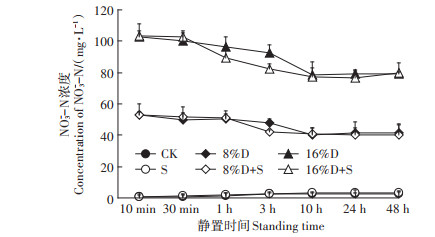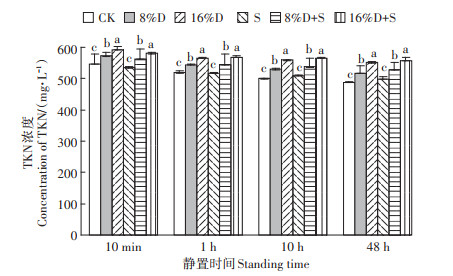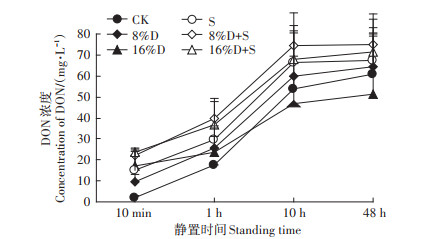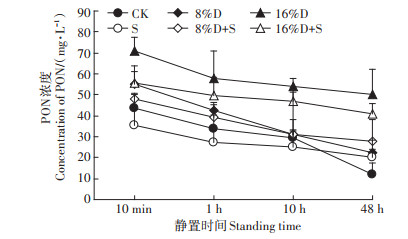2. 新疆农业大学草业与环境科学学院, 乌鲁木齐 830052
2. College of Grass and Environmental Sciences, Xinjiang Agricultural University, Urumqi 830052, China
氮肥在提高作物产量和促进农业发展方面具有重要的作用。然而,氮肥施入土壤后40%~60%通过挥发、淋溶和反硝化作用损失[1]。伴随农业绿色发展理念和化肥减量行动,富含氮素的液态肥料沼液作为化学氮肥的替代品得到广泛认可[2-3]。然而,沼液施入土壤后,相当一部分氮素也会以硝态氮形式淋溶,一部分则以氨挥发等气态形式损失,损失的氮素不仅造成氮素流失,而且可能对水体造成污染[4-5],因此研制开发高效控制沼液氮素形态转化及损失的技术非常重要。土壤氮素损失的阻控方法较多[6-8],其中,硝化抑制剂可减缓土壤铵态氮向NO3-的转化[9],减少土壤NO3-的淋溶[10]以及土壤N2O气态损失[11]。目前应用最广的硝化抑制剂是双氰胺(DCD)。张露等[1]、刘常珍等[12]研究表明,DCD具有明显的硝化抑制效果,抑制NH4+向NO3-转化,延缓NH4+-N到达峰值时间,降低土壤NO3-含量,减少NO3--N的淋失。课题组前期通过模拟试验发现,在土壤中添加DCD可以降低沼液灌溉过程45.89%NO3--N淋溶[13]。DCD也是一种易溶于水的有机含氮化合物,分子式为C2H4N4,氮含量69.6%,其施用在土壤中可分解为H2O、CO2和NH4+[14-15]。另外,有机硅表面活性剂主要通过物理作用减少土壤氮素损失,其成分主要是乙氧基改性三硅氧烷化合物[16],具有良好的润湿性、极佳的延展性、较强的黏附力、气孔渗透率和良好的抗雨冲刷性等特性,可有效降低溶液的表面张力,促进溶液在生物表面的铺展和润湿能力[17]。
综上,已有的研究多是将DCD直接添加至土壤中或者将表面活性剂添加至农药溶液中作为助剂使用。但施入土壤中的DCD在剖面中向下移动较快,易与土壤NH4+富集层分离,从而降低硝化抑制效果。本研究拟通过室内模拟试验,探求DCD和表面活性剂直接添加至沼液后,其对沼液中氮素形态和含量的影响,为提高抑制剂抑制效果和科学施用抑制剂提供数据支撑和理论依据。
1 材料与方法 1.1 试验材料沼液取自天津市益利来养殖有限公司常年运转的塞流式厌氧反应器,原料为猪厂粪污。沼液pH值为7.46,总氮(TN)浓度583.43 mg·L-1,铵态氮(NH4+-N)浓度493 mg·L-1,硝态氮(NO3--N)浓度0.7 mg·L-1,COD浓度416.2 mg·L-1,Cu浓度0.16 mg·L-1,Zn浓度0.39 mg·L-1,As浓度0.01 mg·L-1。DCD生产厂家为北京百灵威科技有限公司,分析纯,纯度98%。表面活性剂由青岛农业大学提供。
1.2 试验设计试验设置6个处理:沼液原液(CK);8%DCD+沼液(8%D);16%DCD+沼液(16%D);表面活性剂+沼液(S);8%DCD+表面活性剂+沼液(8%D+S);16%DCD+表面活性剂+沼液(16%D+S)。每个处理重复3次。向广口塑料瓶中加入1 000 mL沼液,每瓶沼液中TN投入583.43 mg,NH4+-N投入493 mg,分别按照DCD和表面活性剂的配施量加入广口塑料瓶中。其中,DCD用量以施入总氮量的百分数计量,8%DCD带入氮浓度68.21 mg·L-1,16%DCD带入氮浓度136.42 mg·L-1,表面活性剂与沼液按照1:750稀释倍数应用。随后,将所有处理放于磁力搅拌机上充分搅拌10 min后静置,分别于静置10、30 min和1、3、10、24、48 h时取上清液,每次取样40 mL,备用。
1.3 测定指标测定沼液中NH4+-N、NH3--N、溶解性凯氏氮(DKN)和总凯氏氮(TKN)浓度。其中,沼液TKN直接进行消解测试,其他指标测试前需将水样预先用0.45 μm纤维滤膜过滤处理。TKN包括总有机氮(TON)、溶解态的NH4+-N[18],以及可能吸附于无机颗粒或胶体表面的颗粒态氨氮(PNH3)[19],但由于其吸附量有限且易受水质理化特征的干扰[20],因而对水相中的PNH3不予考虑[21]。各形态氮素的计算关系式[20]如下:

|
(1) |

|
(2) |
试验数据采用Excel 2010和SPSS 19.0软件进行统计分析。处理间差异显著性采用单因素方差分析法(One-way ANOVA),显著性水平为0.05。
2 结果与分析 2.1 沼液NH4+-N浓度变化沼液NH4+-N浓度随静置时间延长总体呈现逐渐降低的趋势(图 1)。与静置10 min相比,静置48 h后所有处理沼液NH4+-N浓度减少了55.20~80.75 mg·L-1,降幅为10.94%~16.28%。相同静置时间沼液NH4+-N浓度由大到小依次为16%D>16%D+S>8%D>8%D+S> CK>S。与CK处理相比,添加硝化抑制剂DCD的处理沼液NH4+-N浓度均增加,16%D处理NH4+-N浓度增加了1.62%~8.96%,16%D+S处理NH4+-N浓度增加了0.07%~5.88%,均在静置10 h以上时段后NH4+-N浓度显著高于CK处理(P < 0.05)。S处理NH4+-N浓度与CK相比有所降低,但无显著差异(P>0.05)。说明沼液中添加硝化抑制剂DCD增加了NH4+-N浓度,并且DCD添加量越多NH4+-N浓度越高,而添加表面活性剂则对NH4+-N浓度影响较小。

|
同一时间不同字母表示处理间差异显著(P < 0.05)。下同 Different letters on the column indicate significant differences among treatments for the same time(P < 0.05). The same below 图 1 DCD或表面活性剂添加后沼液NH4+-N浓度 Figure 1 The concentration of NH4+-N in biogas slurry after addition of DCD or surfactant |
CK和S处理沼液NO3--N浓度随静置时间延长略有升高,其他处理呈现缓慢降低并趋于平稳的趋势(图 2)。8%D和8%D+S处理NO3--N浓度从52 mg·L-1降至40 mg·L-1,16%D和16%D+S处理NO3--N浓度从103 mg·L-1降至80 mg·L-1,两组降幅相近,约为23%。添加DCD的处理沼液NO3--N浓度比CK显著增加(P < 0.05),8%DCD和16%DCD处理NH3--N浓度分别为CK处理的14.42~54.72倍和27.66~146.88倍。添加相同剂量DCD的两处理NO3--N浓度随静置时间的变化无显著差异(P>0.05)。沼液中添加DCD大幅增加了NO3--N浓度,表面活性剂对NO3--N浓度无显著影响。

|
图 2 DCD或表面活性剂添加后沼液NO3--N浓度 Figure 2 The concentration of NO3--N in biogas slurry after the addition of DCD or surfactant |
各处理沼液TKN浓度随静置时间延长呈现逐渐降低的趋势,与NH4+-N浓度趋势基本一致(图 3)。静置48 h后,沼液中TKN浓度减少了23.40~59.33 mg· L-1,降幅为4.03%~10.83%,其中CK处理减少了10.83%,S处理减少了6.72%,8%D处理减少了9.65%,16%D处理减少了7.07%。与CK相比,添加硝化抑制剂DCD的处理显著增加了TKN浓度,表现为16%D>8%D>CK和16%D+S>8%D+S>S。其中添加8%DCD沼液中TKN增加了24.67~29.52 mg·L-1,添加16%DCD沼液中TKN增加了45.27~59.70 mg·L-1。而添加表面活性剂并没有显著增加沼液中TKN的浓度。

|
图 3 DCD或表面活性剂添加后沼液TKN浓度 Figure 3 The concentration of TKN in biogas slurry after the addition of DCD or surfactant |
随静置时间延长沼液DON浓度迅速增加后趋于稳定(图 4),静置48 h后所有处理浓度增加了33.87~ 59.08 mg·L-1。沼液PON浓度迅速降低后趋于稳定(图 5),静置48 h后所有处理浓度降低了22.06~32.86 mg·L-1。添加DCD处理在静置48 h后沼液DON浓度比静置10 min时平均增加了47.24 mg·L-1,增幅为300.4%;而PON浓度平均减少了38.83 mg·L-1,降幅为36.39%。静置48 h所有处理沼液DON增量均大于PON减量。与CK或S处理相比,添加DCD显著提高了沼液PON浓度(P < 0.05),8%DCD处理沼液PON浓度增加了18.00~30.67 mg·L-1,而16%DCD处理增加了36.33~65.33 mg·L-1。

|
图 4 DCD或表面活性剂添加后沼液DON浓度 Figure 4 The concentration of DON in biogas slurry after addition of DCD or surfactant |

|
图 5 DCD或表面活性剂添加后沼液PON浓度 Figure 5 The concentration of PON in biogas slurry after addition of DCD or surfactant |
沼液中氮素养分含量丰富,氮素形态和组成多样,是一种有机和无机复合的液体氮肥,主要以铵态氮为主[22],本试验中静置后的沼液NH4+-N占TKN的73.1%~89.4%,所有处理沼液NH4+-N浓度随静置时间延长持续下降,与TKN浓度变化趋势相似,但NH4+-N浓度降幅大于TKN。沼液NH4+-N和TKN浓度静置48 h后分别降低了10.94%~16.28%和4.03%~ 10.83%。CK处理初期NH4+-N浓度占TKN的89.42%,48 h后NH4+-N浓度占TKN的85.03%,表明有部分NH4+-N转化成其他形态的氮。沼液存放NH4+-N浓度下降可能与氨挥发、吸附沉淀、硝化作用、微生物和藻类吸收有关[23]。添加DCD处理NH4+-N和TKN浓度的减量均小于CK处理,添加DCD缓解了NH4+-N的降低。
DCD是一种易溶于水的有机含氮化合物,施用于土壤后可分解为H2O、CO2和NH4+[14-15]。有研究表明DCD降解主要通过微生物途径[24],即降解菌产生胞外酶,进而通过酶解作用降解DCD[25]。沼液中因含有极其丰富的细菌和放线菌等微生物[26-27],DCD在沼液这种特殊的液态肥料中易被降解。试验中8%DCD和16%DCD处理带入氮核算浓度分别为68.21 mg·L-1和136.42 mg·L-1,这也使DCD添加后沼液TKN、NH4+-N、NO3--N浓度均显著高于对照处理,并且TKN与NO3--N浓度的增量之和约等于DCD氮素带入量。说明部分DCD可能被沼液含有的微生物降解为NH4+,部分NH4+进一步转化成NO3-,沼液形成了促进DCD降解的环境是延缓NH4+-N转化的重要原因。
沼液静置过程中部分PON减少而DOM增加,可能是由搅拌或取样过程带入的O2所致。PON减量小于DOM增量,表明总有机氮含量发生了变化,本研究还发现DCD添加处理增加了PON的含量,可能是因为DCD被沼液中的厌氧微生物降解。
3.2 表面活性剂添加对沼液氮素形态和浓度的影响试验发现静置48 h后S处理NH4+-N浓度减少了15.67%,降幅大于对照处理,说明添加表面活性剂延缓了NH4+-N的转化,但效果并不显著。整个试验过程中,表面活性剂对氮素形态和浓度的影响不明显,可能因为表面活性剂是一种物理作用展着剂,在沼液这种液态肥料中并未发挥出延展作用。表面活性剂在农业上作为农药助剂,不仅可以降低农药残留,还可以帮助节水[14],降低喷雾液表面张力,具有良好的展扩性和渗透性[28]。而表面活性剂发挥液体延展的性能对沼液氮素形态和浓度的影响还需要进一步研究。
4 结论(1) 添加8%DCD和16%DCD对沼液氮素形态和浓度有显著影响,沼液中NH4+-N、TKN、NO3--N浓度均增加,且NH4+-N、TKN、NO3--N浓度与DCD添加量呈正相关。
(2) 表面活性剂添加对沼液氮素形态和浓度没有显著影响。
| [1] |
张露, 皮荷杰, 周细红, 等. 双氰胺在不同温度下对碱性土尿素氮转化的影响[J]. 水土保持通报, 2015, 35(6): 172-177. ZHANG Lu, PI He -jie, ZHOU Xi-hong, et al. Effects of dicyandiamide on urea nitrogen transformation in alkaline soil in different temperatures[J]. Bulletin of Soil and Water Conservation, 2015, 35(6): 172-177. |
| [2] |
王卫平, 朱凤香, 陈晓旸, 等. 沼液浇灌对露地西瓜产量及土壤环境的影响[J]. 浙江农业科学, 2015, 56(7): 1024-1026. WANG Wei-ping, ZHU Feng-xiang, CHEN Xiao-yang, et al. Effect of biogas slurry irrigation on watermelon yield and soil environment in open field[J]. Journal of Zhejiang Agricultural Sciences, 2015, 56(7): 1024-1026. |
| [3] |
赵麒淋.旱旱轮作模式下沼液连续施用对土壤质量和玉米产量及品质的影响研究[D].雅安: 四川农业大学, 2012. ZHAO Qi-lin. Effect of biogas slurry on quality of soil and maize yield, nutritional quality under dryland rotation mode[D]. Ya'an: Sichuan Agricultural University, 2012. |
| [4] |
Daudén A, Quilez D. Pig slurry versus mineral fertilization on corn yield and nitrate leaching in a Mediterranean irrigated environment[J]. European Journal of Agronomy, 2004, 21: 7-19. DOI:10.1016/S1161-0301(03)00056-X |
| [5] |
Mantovi P, Fumagalli L, Beretta G P, et al. Nitrate leaching through the unsaturated zone following pig slurry applications[J]. Journal of Hydrology, 2006, 31(6): 195-212. |
| [6] |
张相松, 刘兆辉, 江丽华, 等. 设施菜地土壤硝态氮淋溶防控技术的研究[J]. 青岛农业大学学报(自然科学版), 2009, 26(3): 207-211. ZHANG Xiang -song, LIU Zhao-hui, JIANG Li-hua, et al. Study on the technology of soil nitrate nitrogen leaching preventive and control in mushroom house[J]. Journal of Qingdao Agricultural University(Natural Science), 2009, 26(3): 207-211. |
| [7] |
张继宗, 刘培财, 左强, 等. 北方设施菜地夏季不同填闲作物的吸氮效果比较研究[J]. 农业环境科学学报, 2009, 28(12): 263-266. ZHANG Ji-zong, LIU Pei-cai, ZUO Qiang, et al. Comparative study on nitrogen uptake effect of different idle crops in protected vegetable fields in northern China in summer[J]. Journal of Agro-Environment Science, 2009, 28(12): 263-266. |
| [8] |
刘倩.硝化抑制剂对土壤的硝化抑制效应及其微生物作用机理[D].石河子: 石河子大学, 2011. LIU Qian. Effect of different NIs on soil nitrification inhibition and its microbial mechanism[D]. Shihezi: Shihezi University, 2011. |
| [9] |
王凤霞, 刘旭, 杨俊, 等. 硝化抑制剂研究概况[J]. 云南化工, 2018, 45(2): 69-71. WANG Feng-xia, LIU Xu, YANG Jun, et al. Research overview of nitrification inhibitors[J]. Yunnan Chemical Technology, 2018, 45(2): 69-71. |
| [10] |
周旋, 吴良欢, 戴锋. 生化抑制剂组合对黄泥田土壤尿素态氮转化的影响[J]. 水土保持学报, 2015, 29(5): 95-100, 23. ZHOU Xuan, WU Liang-huan, DAI Feng. Effects of combined biochemical inhibitors on the transformation of urea-N in yellow clayey soil[J]. Journal of Soil and Water Conservation, 2015, 29(5): 95-100, 23. |
| [11] |
陈晨, 王春隆, 周璐瑶, 等. 施用生物炭和硝化抑制剂对菜地N2O排放和蔬菜产量的影响[J]. 南京农业大学学报, 2017, 40(2): 287-294. CHEN Chen, WANG Chun-long, ZHOU Lu-yao, et al. Effects of biochar and nitrification inhibitor amendment on N2O emissions and vegetable yield under intensive vegetable production[J]. Journal of Nanjing Agricultural University, 2017, 40(2): 287-294. |
| [12] |
刘常珍, 胡正义, 赵言文, 等. 元素硫和双氰胺对菜地土壤铵态氮硝化抑制协同效应研究[J]. 植物营养与肥料学报, 2008, 14(2): 334-338. LIU Chang-zhen, HU Zheng-yi, ZHAO Yan-wen, et al. Synergistic nitrification-inhibiting effect of elemental sulfur and dicyandiamide in a typical vegetable soil[J]. Journal of Plant Nutrition and Fertilizers, 2008, 14(2): 334-338. |
| [13] |
杨涵博, 赖睿特, 张克强, 等. 硝化抑制剂阻控养殖肥液灌溉土壤氮素淋失[J]. 农业环境科学学报, 2019, 38(8): 1751-1758. YANG Han-bo, LAI Rui-te, ZHANG Ke-qiang, et al. Nitrification inhibitors prevent nitrogen leaching in soil irrigated by biomas slurry[J]. Journal of Agro-Environment Science, 2019, 38(8): 1751-1758. |
| [14] |
Kelliher F M, Clough T J, Clark H, et al. The temperature dependence of dicyandiamide(DCD)degradation in soils:A data synthesis[J]. Soil Biology and Biochemistry, 2008, 40(7): 1878-1882. DOI:10.1016/j.soilbio.2008.03.013 |
| [15] |
Klein C A M, Cameron K C, Di H J, et al. Repeated annual use of the nitrification inhibitor dicyandiamide(DCD)does not alter its effectiveness in reducing N2O emissions from cow urine[J]. Animal Feed Science and Technology, 2011, 166(7): 480-491. |
| [16] |
鲁洪斌. 有机硅表面活性剂作为农药助剂的原理及应用[J]. 河北农业, 2019(4): 40-41. LU Hong-bin. The principle and application of organosilicon surfactant as pesticide assistant[J]. Hebei Agriculture, 2019(4): 40-41. |
| [17] |
陈杰, 何亮. 有机硅表面活性剂在农药中的应用[J]. 吉林化工学院学报, 2012, 29(9): 29-31. CHEN Jie, HE Liang. Application of silicone surfactant in pesticide[J]. Journal of Jilin Institute of Chemical Technology, 2012, 29(9): 29-31. |
| [18] |
国家环境保护总局. 水和废水监测分析方法[M]. 四版. 北京: 中国环境科学出版社, 2002: 254-281. State Environmental Protection Administration. Methods for monitoring and analysis of water and wastewater[M]. 4th Edition. Beijing: China Environmental Science Press, 2002: 254-281. |
| [19] |
Wetzel R G. Limnology:Lake and river ecosystems[M]. 3rd Edition. San Diego: Academic Press, 2001.
|
| [20] |
Allan J D, Castillo M M. Stream ecology:Structure and function of running waters[M]. 2nd Edition. Dordrecht: Springer Press, 2007: 256-264.
|
| [21] |
沈志良, 刘群, 张淑美. 长江总氮和有机氮的分布变化与迁移[J]. 海洋与湖沼, 2003, 34(6): 577-585. SHEN Zhi-liang, LIU Qun, ZHANG Shu-mei. Distribution, variation and migration of total nitrogen and organic nitrogen in the Yangtze River[J]. Oceanologia et Limnologia Sinica, 2003, 34(6): 577-585. |
| [22] |
赵国华, 陈贵, 徐劼. 猪粪尿源沼液中主要养分和重金属分布特性[J]. 浙江农业科学, 2014, 55(9): 1454-1456. ZHAO Guo-hua, CHEN Gui, XU Jie. Distribution characteristics of main nutrients and heavy metals in biogas slurry from pig manure and urine[J]. Journal of Zhejiang Agricultural Sciences, 2014, 55(9): 1454-1456. |
| [23] |
吴华山, 郭德杰, 马艳, 等. 猪粪沼液贮存过程中养分变化[J]. 农业环境科学学报, 2012, 31(12): 2493-2499. WU Hua-shan, GUO De-jie, MA Yan, et al. Changes of nutrients in anaerobically digested slurry of pig manure during storage[J]. Journal of Agro-Environment Science, 2012, 31(12): 2493-2499. |
| [24] |
Rajbanshi S S, Benckiser G, Ottow J C G. Mineralization kinetics and utilization as an N source of dicyandiamide(DCD)in soil[J]. Nautrwissenschaften, 1992, 79(1): 26-27. DOI:10.1007/BF01132276 |
| [25] |
Schwarzer C, Haselwandter K. Enzymatic degradation of the nitrification inhibitor dicyandiamide by a soil bacterium[J]. Soil Biology and Biochemistry, 1991, 23(3): 309-310. DOI:10.1016/0038-0717(91)90070-Z |
| [26] |
郝鲜俊, 洪坚平, 乔志伟. 沼液对甘蓝连作土壤生物学性质的影响[J]. 应用与环境生物学报, 2011, 17(3): 384-387. HAO Xian-jun, HONG Jian-ping, QIAO Zhi-wei. Effect of biogas slurry on biological properties of cabbage continuous cropping soil[J]. Chinese Journal of Applied and Environmental Biology, 2011, 17(3): 384-387. |
| [27] |
杨子峰, 陈伟强, 王伟, 等. 沼液施用对西兰花耕作土壤微生物特性的影响[J]. 中国农学通报, 2017, 33(29): 112-115. YANG Zi-feng, CHEN Wei-qiang, WANG Wei, et al. Effects of biogas slurry on soil microbial characteristics of broccoli[J]. Chinese Agricultural Science Bulletin, 2017, 33(29): 112-115. |
| [28] |
李晓光, 周宏慧, 李妍, 等. 有机硅表面活性剂的特性及在农药中的应用[J]. 广东化工, 2010, 37(10): 69-70. LI Xiao-guang, ZHOU Hong-hui, LI Yan, et al. The characteristic of silicone surfactant and the use in pesticide[J]. Guangdong Chemical Industry, 2010, 37(10): 69-70. |
 2020, Vol. 37
2020, Vol. 37


